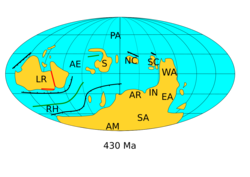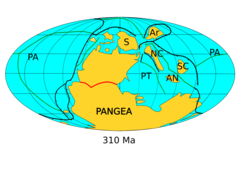Laurentia

Laurentia is a large continental craton. It forms the ancient geological core of the North American continent.
Originally, it included the core of Greenland and the northwestern part of Scotland, known as the Hebridean Terrane. Laurentia is also called the North American Craton. It is a modern geological feature, and it is also a very ancient geological core made of igneous rock. It is nearly four billion years old.
At times in the past, Laurentia has been part of larger continents and supercontinents. It is an assembly of smaller tectonic plates which merged early in the Archaean era. As the plates moved together, a huge range of mountains formed. Much later, in the Proterozoic era, small plates and oceanic islands collided with and fused with the ever-growing Laurentia. Together they made the huge, stable craton we see today as the north and center of North America and the west of Greenland.[1]
Over a billion years ago, the Grenville Orogeny in the Canadian Shield made jagged peaks, higher than any of today's mountains. Millions of years of erosion have changed these mountains to rolling hills.[2]
The remaining, western, part of North America was added much later, after Pangaea split up, and the Americas moved west from Eurasia and Gondwana.
The craton is named after the Laurentian Mountains, a range to the north of the St. Lawrence River.
Rocks as seen today
The cratonic rocks are metamorphic and igneous, while the overlying sedimentary rocks are composed mostly of limestones, sandstones, and shales.[3] These sedimentary rocks were deposited from 650 to 290 million years ago.[4] In eastern and central Canada, much of the stable craton is exposed at the surface.
The southwestern portion of Laurentia consists of Precambrian basement rocks deformed by continental collisions (violet area of the image above). This area has been subjected to considerable rifting as the Basin and Range Province and has been stretched up to 100% of its original width.[5] The area has a history of major volcanic eruptions.
Laurentia Media
References
- ↑ Dalziel I.W.D. 1992. "On the organization of American plates in the Neoproterozoic and the breakout of Laurentia". GSA Today. 2 (11): 237–241.
- ↑ James-Abra, Erin. "Canadian Shield". Canadian Encyclopedia. Retrieved 24 January 2018.
- ↑ Sloss, L.L. (1988). "Conclusions, Chapter 17: The Geology of North America". Sedimentary cover - North American Craton. Vol. D-2. pp. 493–496.
- ↑ Burgess, P.M. Gurnis, M., and Moresi, L. (1997). "Formation of sequences in the cratonic interior of North America by interaction between mantle, eustatic, and stratigraphic processes". Geological Society of America Bulletin. 109 (12): 1515–1535. Bibcode:1997GSAB..109.1515B. doi:10.1130/0016-7606(1997)109<1515:FOSITC>2.3.CO;2. S2CID 140723924.
{{cite journal}}: CS1 maint: multiple names: authors list (link) - ↑ "Geologic provinces of the United States: Basin and Range Province". USGS.gov website. Archived from the original on 25 January 2009. Retrieved 9 November 2009.



